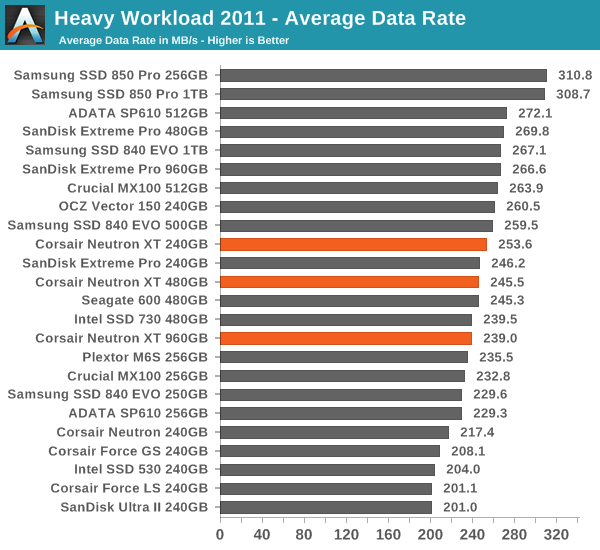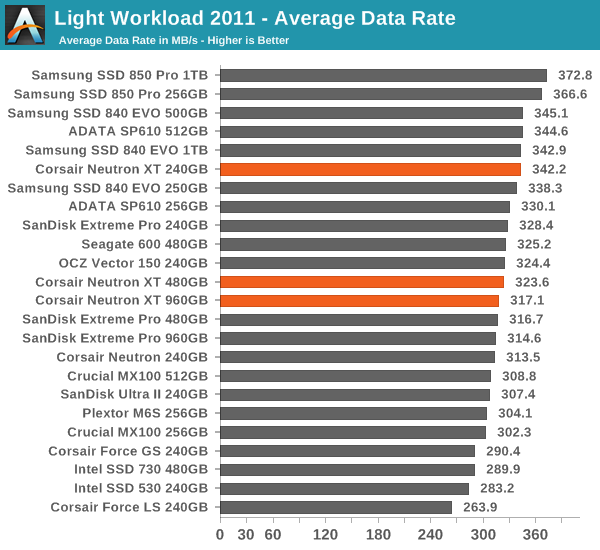Corsair Neutron XT (240GB, 480GB & 960GB) SSD Review: Phison S10 Debuts
by Kristian Vättö on November 17, 2014 9:00 AM ESTAnandTech Storage Bench 2011
Back in 2011 (which seems like so long ago now!), we introduced our AnandTech Storage Bench, a suite of benchmarks that took traces of real OS/application usage and played them back in a repeatable manner. The MOASB, officially called AnandTech Storage Bench 2011 – Heavy Workload, mainly focuses on peak IO performance and basic garbage collection routines. There is a lot of downloading and application installing that happens during the course of this test. Our thinking was that it's during application installs, file copies, downloading and multitasking with all of this that you can really notice performance differences between drives. The full description of the Heavy test can be found here, while the Light workload details are here.

The same story continues in our 2011 Storage Benches. The Neutron XT is an upgrade – and actually a fairly substantial one – from the Force LS, but it doesn't break any records. Also, what's a bit surprising is that the performance drops as the capacity increases because the 240GB is the fastest of the Neutron XT family. This isn't uncommon because the larger capacities have more LBAs to track, which requires more processing power for internal tasks, but it's still something that's worth noting.











56 Comments
View All Comments
SanX - Monday, November 17, 2014 - link
One more average drive. Speeds need to double or price drop to double for that stuff to be interesting again.hojnikb - Monday, November 17, 2014 - link
Yup. If this ends up being priced closer to 850pro, it wont make any sense whatsoever.hojnikb - Monday, November 17, 2014 - link
Any reason why they are using 64Gbit flash on 480GB aswell ?at 512GB raw flash, it should be enough to saturate controller with 128Gbit dies (thats 32 dies).
SleepyFE - Monday, November 17, 2014 - link
How did you count 32 dies? 4x128=512, that's 4 dies. With 8 dies (8x64) you fill all eight channels. Better parallelism. That's how i understand it.Mikemk - Monday, November 17, 2014 - link
4*128Gbit = 4*16GB = 64GB32*128Gbit = 32*16GB=512GB
hojnikb - Tuesday, November 18, 2014 - link
Its in Gigabits, not gigabytes. Single die is 128Gbit (so 16GB) so you need 32 of them to get 512GB.SleepyFE - Tuesday, November 18, 2014 - link
Sorry about that. So used to gigabytes. Aren't the dies stacked to make 64GB packages and then a single bus leads to that bundle?makerofthegames - Monday, November 17, 2014 - link
tl;dr it's not a bad drive, but it's not good in any particular niche. If it's not cheaper than the dozens of similarly good-enough drives out there, it's a dead product.beginner99 - Monday, November 17, 2014 - link
Exactly. And given the crucial mx100 pricing and performance which should suit almost any consumer and enthusiast it's hard to come up for any reason to buy this unless it is cheaper (highly doubt that). And if you really need ultimate performance you will go Sandisk or 950 pro (or intel pcie).Mikemk - Monday, November 17, 2014 - link
850 pro?